St. Petersburg, Russia
St. Petersburg was a two day stop, and it included a cruise on the Neva River and a few canals. |
A
relatively recent sculpture of Peter the Great, who founded St.
Petersburg in 1703. Prior to this, he had traveled widely in
Europe to learn how one creates an effective navy. He fought
battles with the Ottomans and with Sweden, and his path to the sea was
St. Petersburg, built on land captured from Sweden. Peter was
determined to make St. Petersburg the Russian capital, and that it
should mirror the Europe that he found in his travels.
Besides St. Petersburg, Peter ruthlessly established Russia as an empire. | 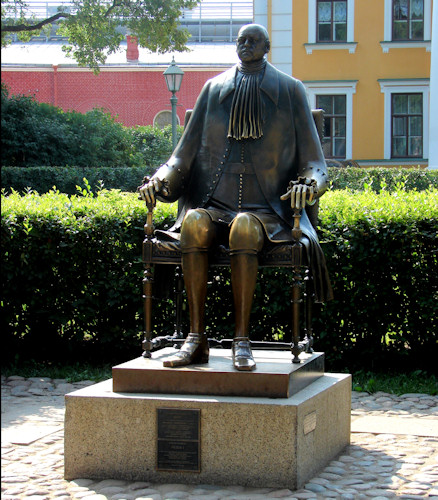
|
| Logically,
the first structure in St. Petersburg was a fortress, Peter and Paul
Fortress to be exact. This was built to fend off the Swedes, if
they tried to come back. | 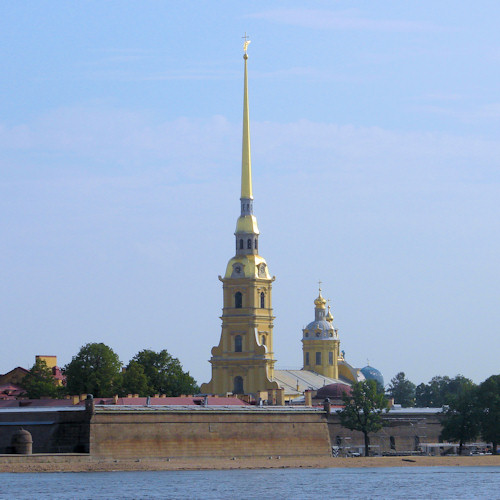 |
A
keystone of the Peter and Paul Fortress is the Peter and Paul
Cathedral. But look at this spire! It could have been
designed by Christopher Wren!
This cathedral now holds the tombs of almost all the tsars from Peter the Great to Nicholas II. Only two are missing. | 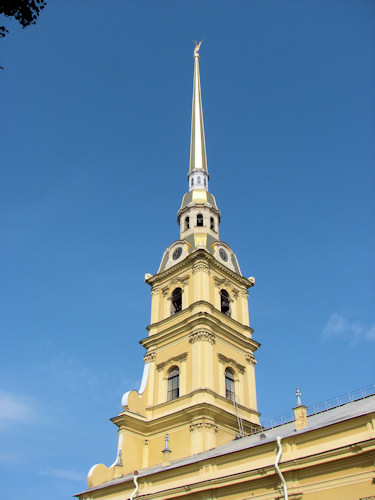
|
| Prior
to the communist revolution, this was the Stock Exchange. Absent
private ownership, this was turned into a naval museum. | 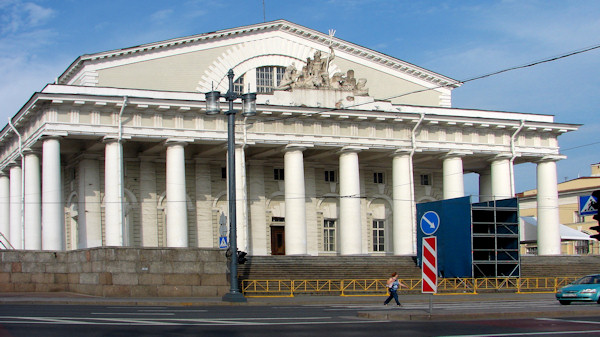
|
| The rivers and canals of St. Petersburg are lined with massive palaces, and the Western influence is evident. | 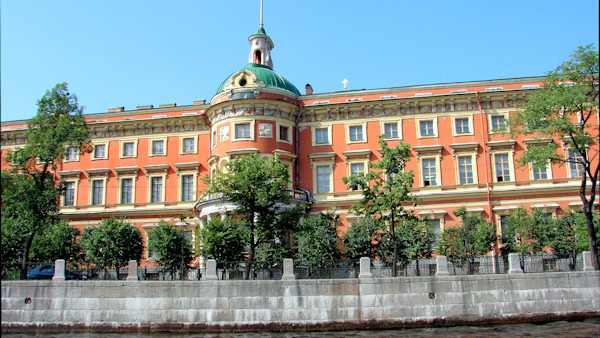
|
The
Winter Palace was official home of the tsars from 1732 until 1917.
Its style is now called Elizabethan Baroque. Its occupancy
was seriously terminated when it was stormed by the Bolsheviks in 1917.
It was also shelled by the battleship Aurora in the same action.
Actually, the last government to use this building was the Kerensky government, which was no match for the Bolsheviks.
Shortly after its storming, the Winter Palace was declared to be part of the Hermitage Museum. | 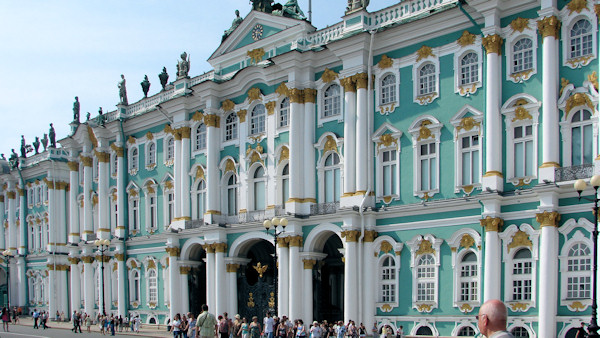
|
| Within the Hermitage, you see the stress between its role as a historical palace and its role as a museum. | 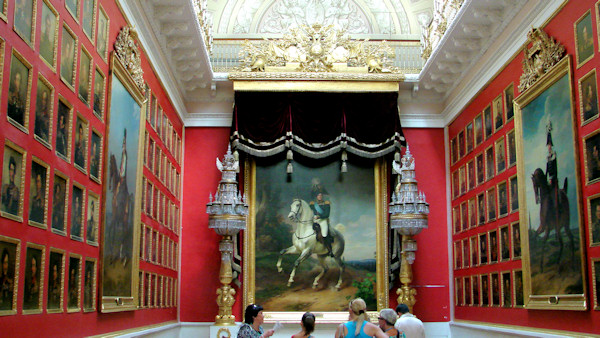
|
Many of the rooms are clearly palatial, as illustrated by this dome.
| 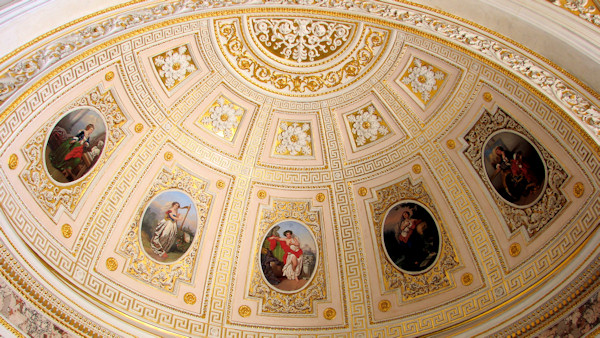 |
| It
really seems like the art suffers, because there is no air conditioning
in most of the Hermitage, because that would not be historically
correct. And the lighting is poor, depending a great deal on the
outside daylight. The paintings, hugely valuable paintings,
suffer from the poor atmosphere. This is Leonardo's 1475-1478 Madonna with the Flower (Benois Madonna). In this picture, it is hard to see the flower because of reflections off the glass over the painting. | 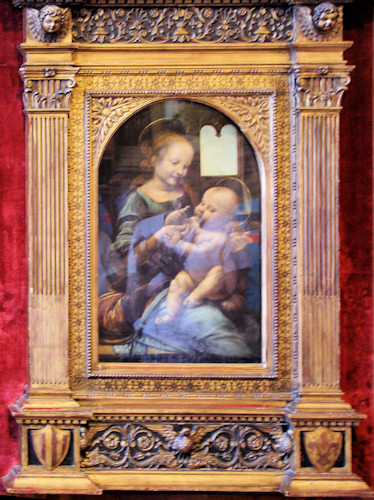
|
| St.
Isaac's Cathedral continues the Western tradition, but it is old enough
to have been the site of Peter the Great's official marriage to his
wife Catherine. | 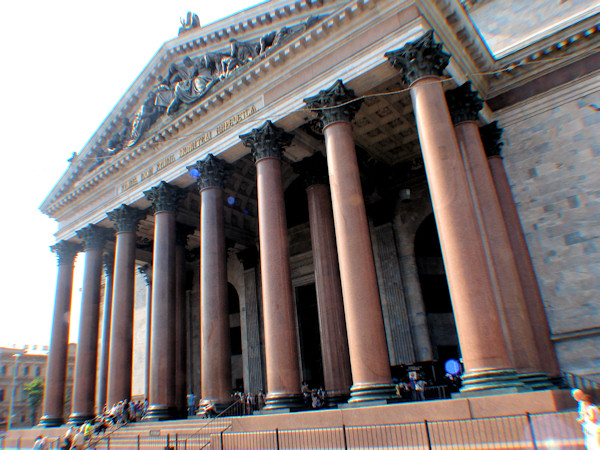
|
| This dome of St. Isaac's is reminiscent of St. Paul's in London. | 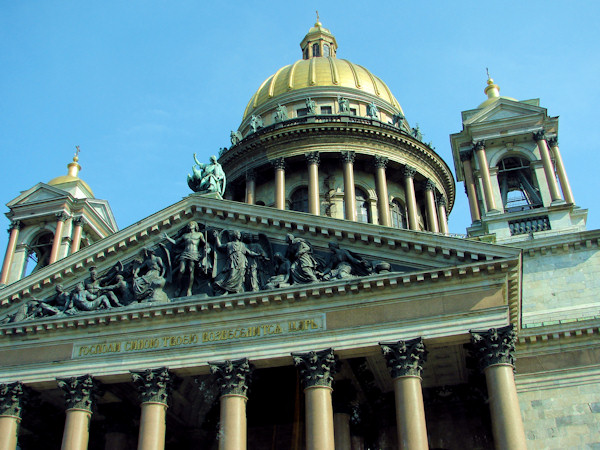
|
| This is the interior view of the central dome of St. Isaac's. Note the dove in the center. | 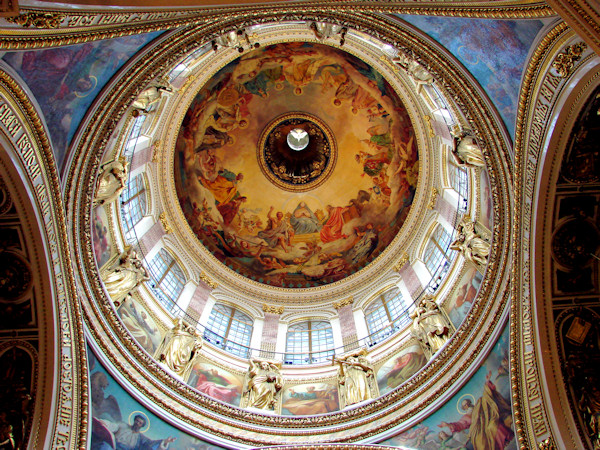
|
| St. Isaac's iconostasis is marked by its elegance and the malachite and lapis lazuli columns. | 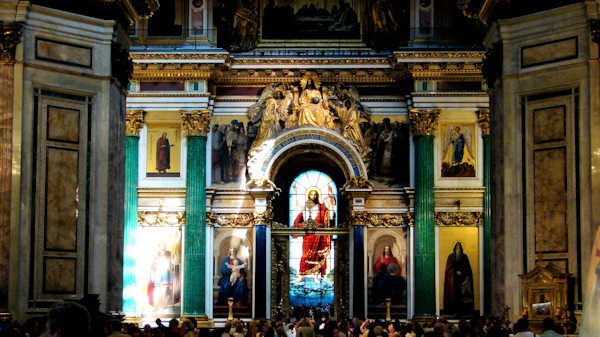
|
The
big exception to western architecture is the Church of the Savior on
the Spilled Blood. Within the church is a shrine on the site
where Tsar Alexander II was assassinated in 1881.
This picture is from the 2010 trip, when I really didn't have good light on the front. | 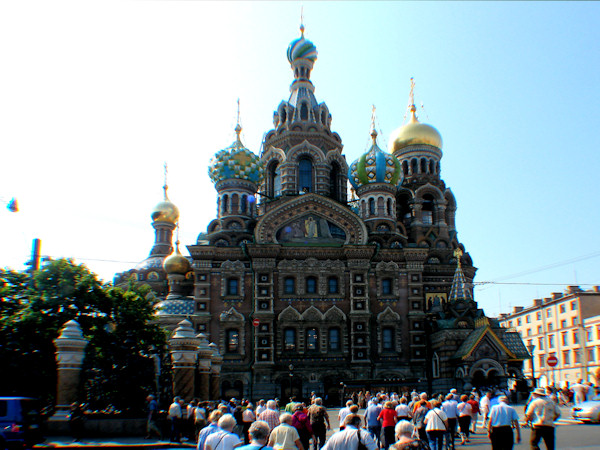
|
| In better light, on the back, the domes absolutely sparkle! | 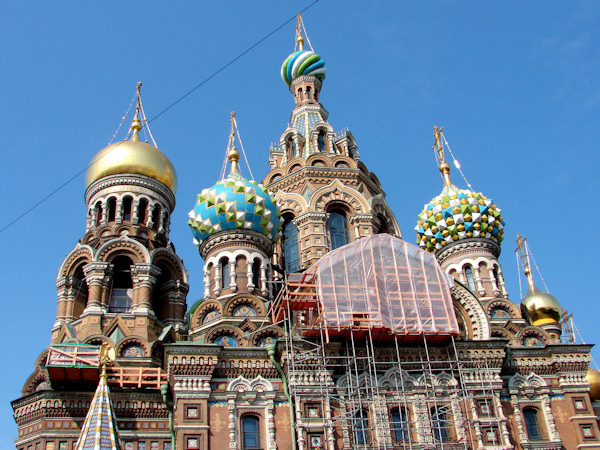
|
| Each dome is line with mosaics, and this is the central dome with an image of Christ. | 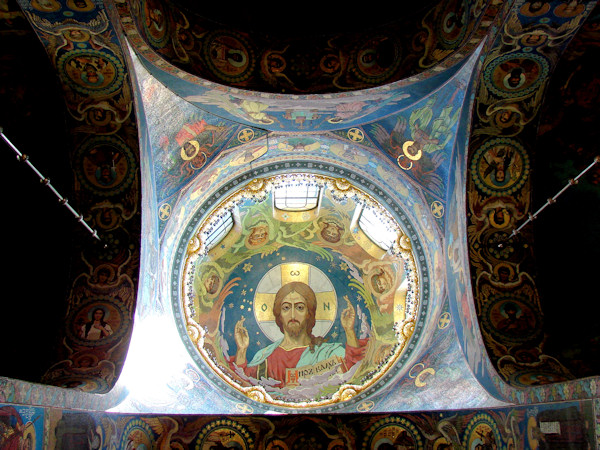 |
Actually, the entire church is lined with mosaics. This example is on one of the interior columns.
This
church was not destroyed but not preserved through the Communist era.
Among other things, it served as a potato warehouse.
However, its restoration started in 1967, and it took 30 years. | 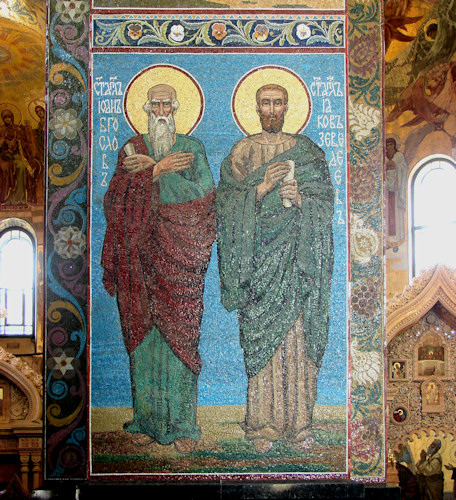
|
One
of our lunch venues was the Russian Club, just across the canal from
the Church of the Savior on the Spilled Blood.
We had beef stroganof here.
| 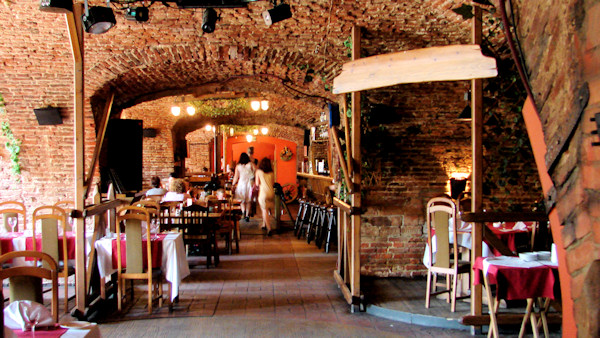
|
The
cruiser Aurora was built in 1903 for the Pacific Fleet, and it saw
action in the Russo-Japanese War. After that it came back to St.
Petersburg and saw service in the Baltic during World War I. By
October 1917, most of the crew had joined the Bolsheviks. Then on
October 25, a blank shot from her forward gun signaled the start of the
Bolshevik's storming the Winter Palace.
Now, it rests in the Neva as a museum and training ship. | 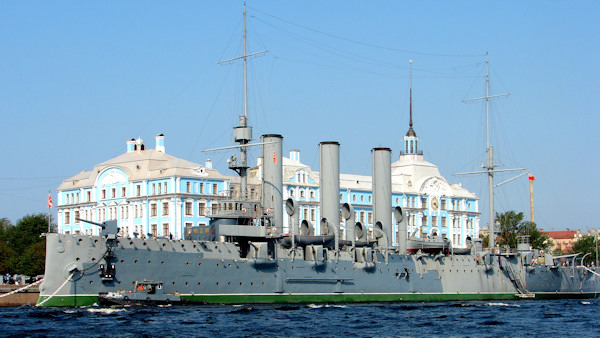
|
| We
were in St. Petersburg a day or two before a big navy parade, and the
Neva was chock full of the Russian Navy. These guided missile
cruisers looked much more ominous than the Aurora. | 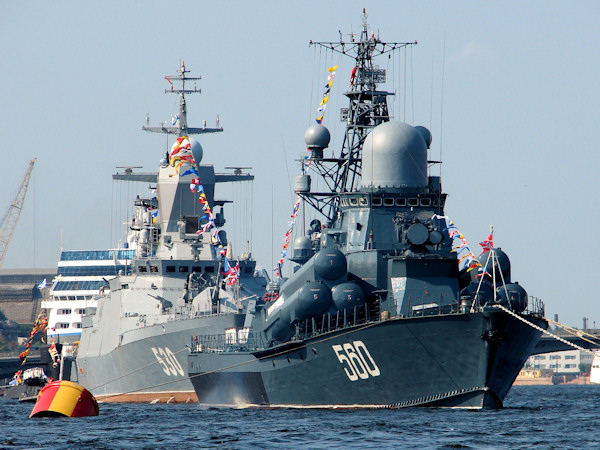
|
St.
Petersburg was besieged by Hitler's army for 872 days from September
1941 until January 1944. This is part of a World War II monument
in memory of that devastating siege. All bronze and socialist
realism.
The German Panzers rolled right through Estonia to get here. | 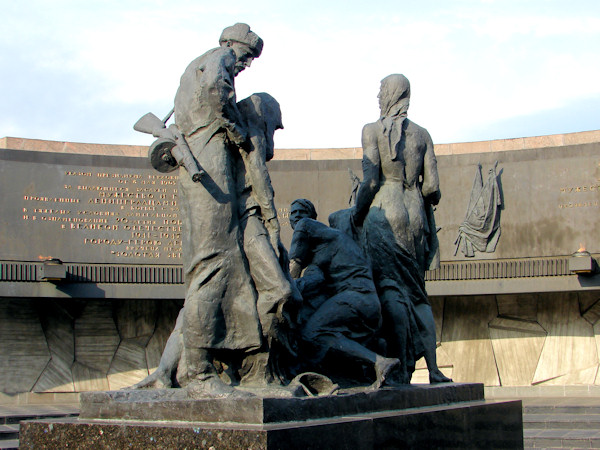
|
During
the siege, the Germans occupied (and trashed) this palace, known as
Catherine's Summer Palace. Peter the Great presented this
palace to his wife Catherine in 1710. (Note that this
is Catherine I; Catherine II was known as Catherine the Great.)
During
the unsettled times from 1905 until his death, Nicholas II spent more
time here than in the Winter Palace in St. Petersburg. | 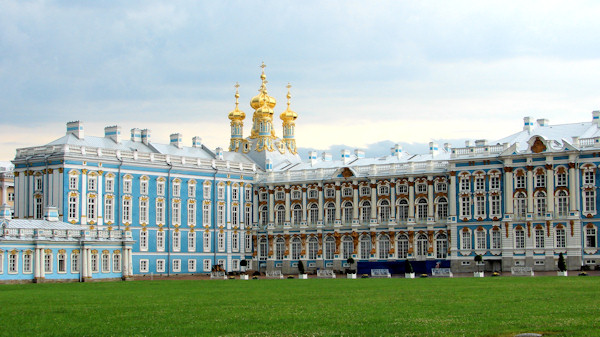
|
| Within Catherine's Summer Palace, the Great Hall is a shameless copy of Versailles. | 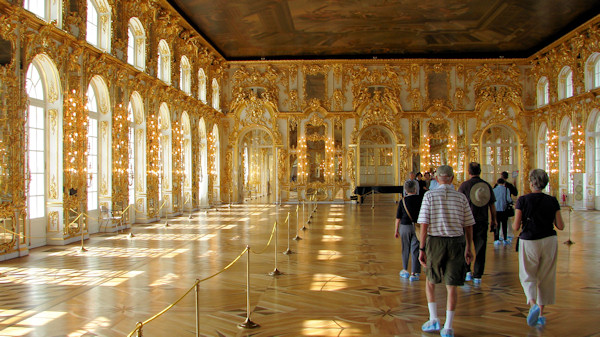
|
| Ceilings are just another site for art in the Summer Palace. | 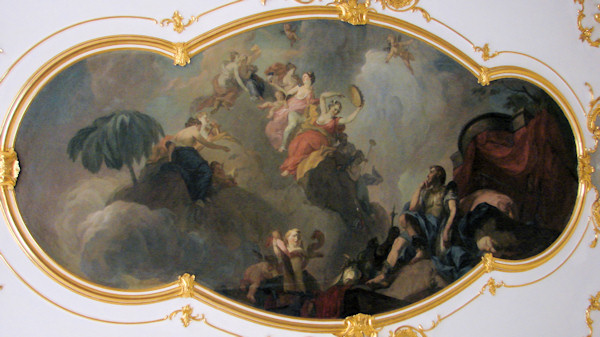
|
Arguably,
our most impressive lunch was at the Restaurant Podvorye in the village
of Pavlosk, just a mile or two from Catherine's Summer Palace. Podvorye means "coach house ."
In an appropriately Russian way, the meal started with freezing cold vodka followed by Russian borscht. | 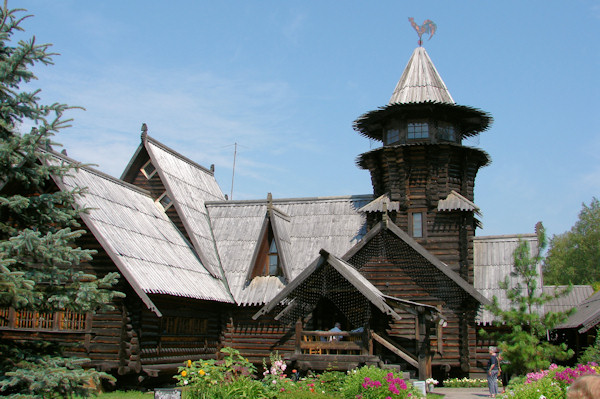
|
| A couple of times during lunch, we were serenaded by this group. The music was fine, but the lyrics were inscrutable. | 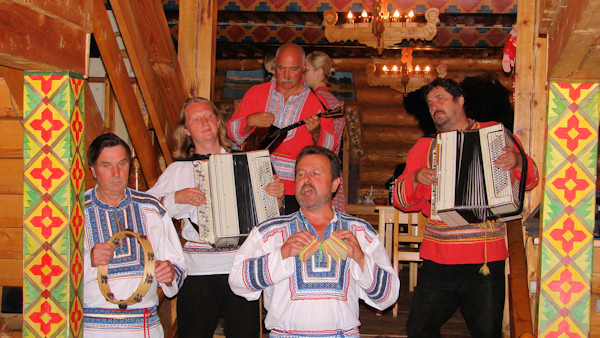
|
| Helsinki, Finland |
| Helsinki
is the capital and largest city in Finland. Its population is
just under 600,000, and the whole country is about 5.4 million.
Viewed from the top deck of Discover, Helsinki shows two major landmarks, both churches. | 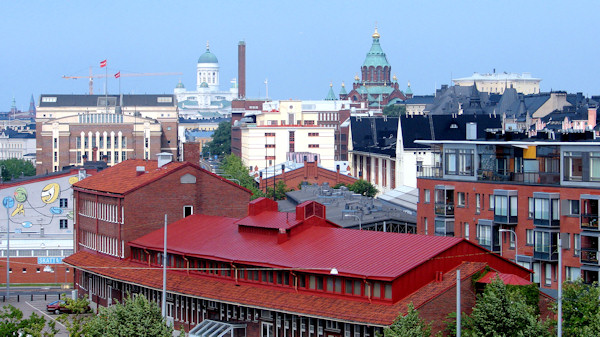
|
| One
of the key landmarks is the Uspenski Russian Orthodox Cathedral.
This was completed in 1868. At that time, Finland was a
Grand Duchy of the Russian Empire. | 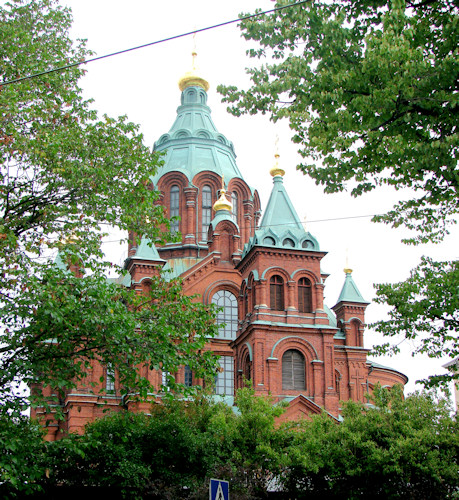
|
The
Helsinki Cathedral is Evangelical Lutheran, but its architecture with a
central, major dome surrounded by four lesser domes is reminiscent of
St. Isaacs in St. Petersburg. When it was completed in 1852, it
was called St. Nicholas' Church and dedicated to the Grand Duke of
Finland, Nicholas I, Tsar of the Russian Empire.
That name was dropped in 1917 when Finland fought for and won its freedom from Russia. | 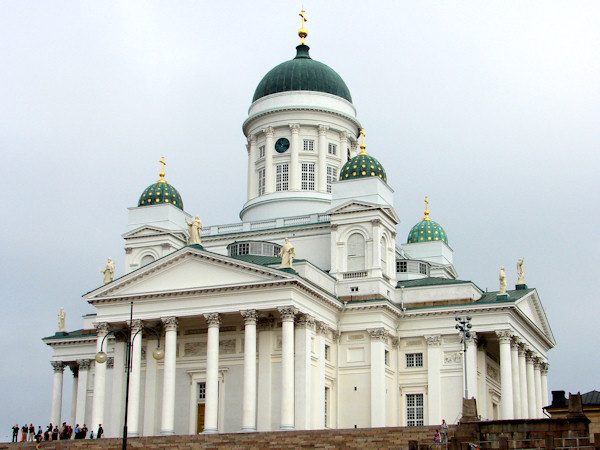 |
| Along
Helsinki's waterfront there is a big market square. A lot of the
stuff is seen in markets everywhere, but I thought this stall caught
the spirit of the neighborhood. |  |
Jean
Sibelius is almost a saint in Finland. We all know that he is the
composer of "Finlandia." The house where he used to live is big
on the tour bus circuit, even though it is well into the countryside.
This
1967 monument is much more satisfying than his house. It is 24
tons of hollow stainless steel pipes. Very abstract. | 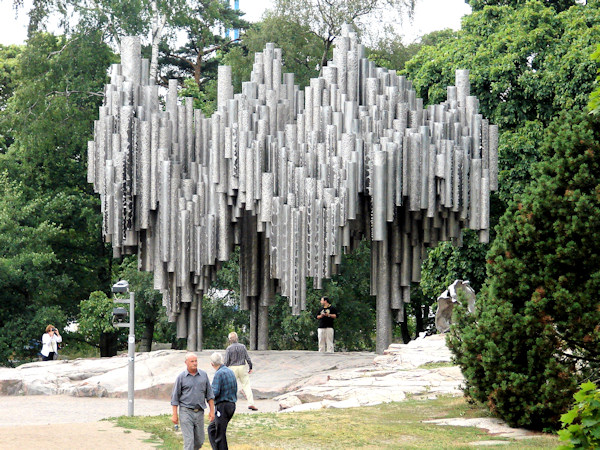 |
| Another
famous Finnish name is Saarinen. The architect Eliel Saarinen
designed this station in Jugendstil, which is German for Art Nouveau.
It was completed in 1919, even though the planning started around
1904. | 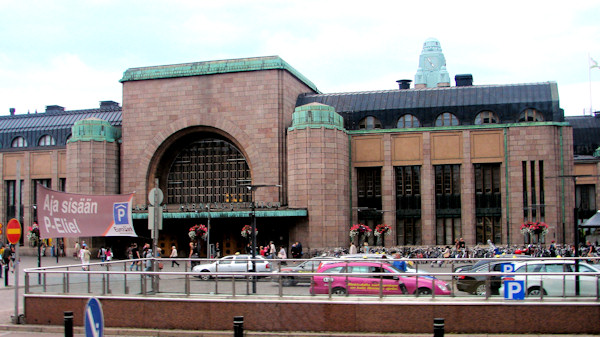
|
| Wismar and Lübeck, Germany |
While
we docked in Warnemünde, the mouth of the Warnow River, we visited
Wismar and Lübeck. Both were founding members of the Hansiatic
League. In spite of having been bombed to smithereens in WW2, the
town still looks Hansiatic.
Wismar had a really good bakery, and we had snacks. | 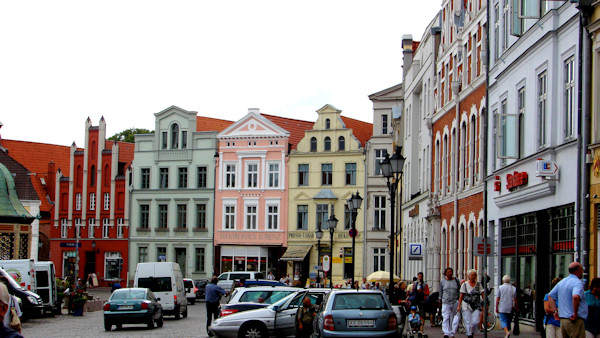
|
| This
building houses a restaurant (bar?) called the Old Swede.
Actually, the Swedes governed this area from 1648 until about
1897. | 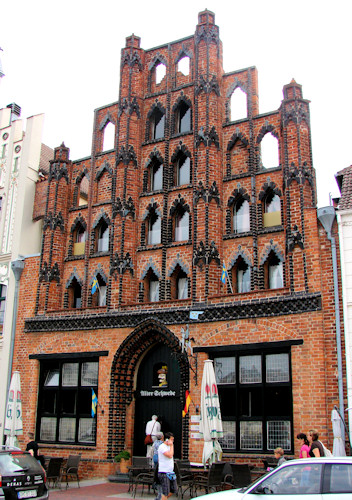
|
| We couldn't have a historic town square without a silly fountain. | 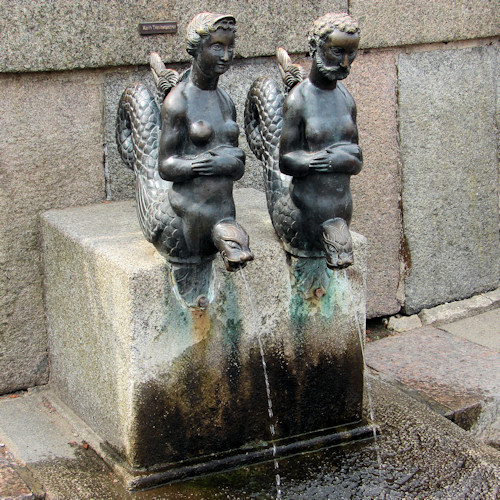 |
| Actually,
the town square shows the current clash of civilization in Germany.
The traditional home made sausage competes with Turkish doner
kebabs. | 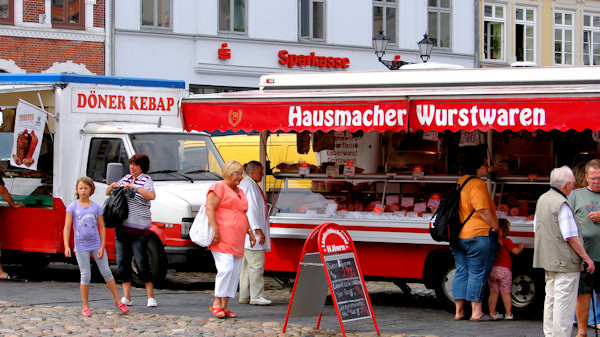 |
| Lübeck
first built their town hall in the 13th century, and continued building
through the 14th and 15th centuries. Consequently, it is a hodge
podge of styles. | 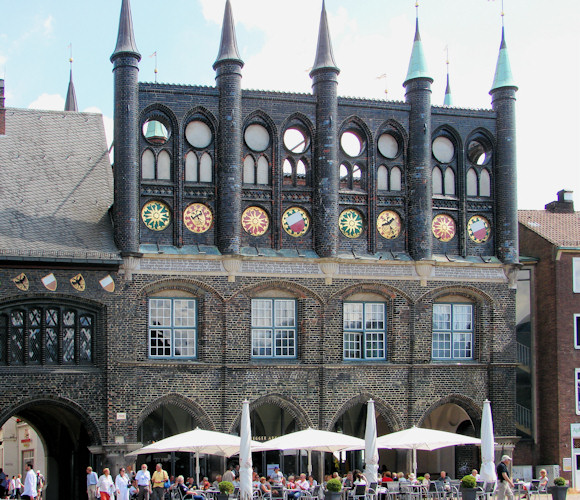 |
| Still
with the town hall, the wall with the wind holes represents some of the
oldest construction. The white facade in front is a Renaissance
addition dating to about 1570. | 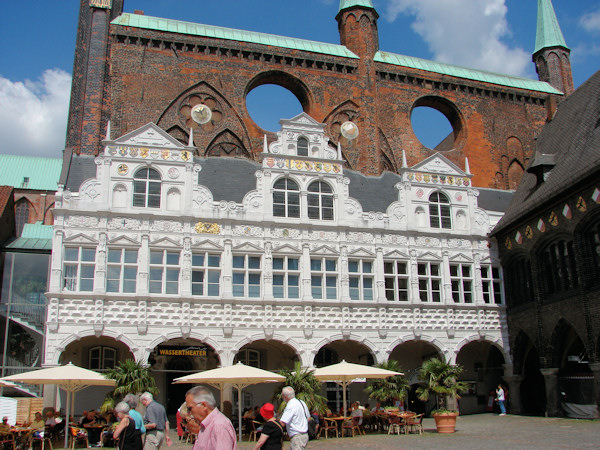
|
| Lübeck
has been home to a lot of notable people. Thomas Mann and Gunter
Grass are two literary examples. A political example is Nobel
laureate Willy Brandt. His home is now a museum, and this
fragment of the Berlin Wall stands in the courtyard. | 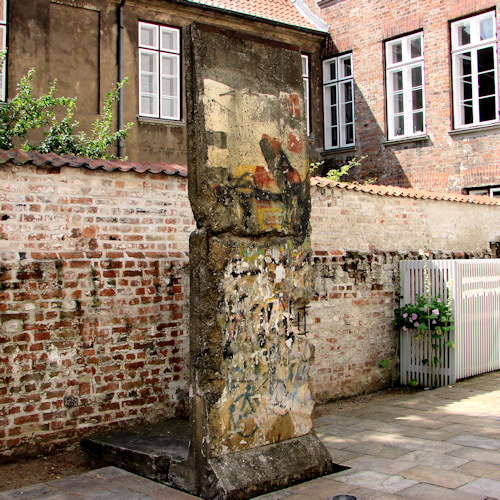
|
| The
old town of Lübeck has a total of seven notable churches. Plus
the Holy Ghost Hospital. This is the Marienkirche,
one of the most important churches in town. It was built between
1250 and 1350, and the style is brick Gothic. This the third
largest church in Germany. | 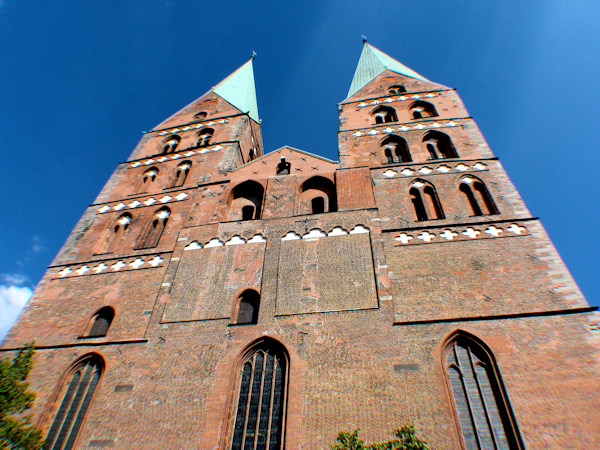
|
| This
Lutheran church has a fine organ, the facade of which is seen here.
Important musical history was made here, too. Dietrich Buxtehude was
organist here from 1668 until 1707. In 1705, he hosted a visiting
organist from down south, Johann Sebastian Bach. It is said that
Buxtehude's elaborate style opened up Bach's organ composition to a
much more exciting terrain. | 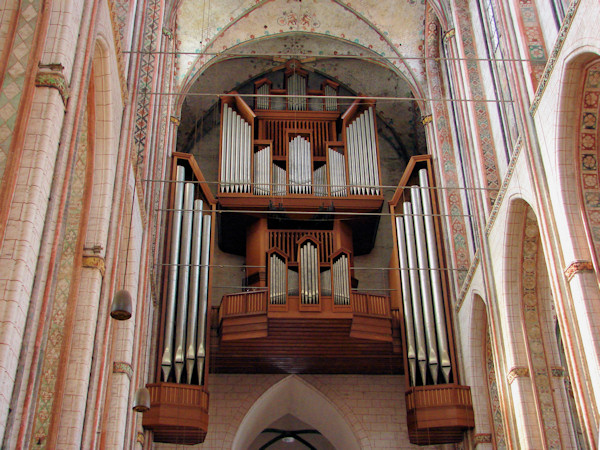 |
| On
Palm Sunday, 1942, Lübeck was hit by an Allied air raid, and the
Marienkirche was hit. The fire-driven winds up the spire made the
bells ring for several minutes before they finally fell. These
are those bells, right where they fell. | 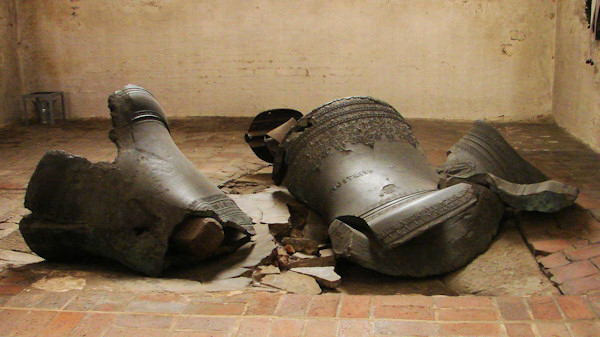 |
| In 1401, the sea captains of Lübeck formed their guild, the Schiffers Gesellschaft. The guild
still exists, but in 1535, they purchased this building as their
meeting place. Since 1868, it has operated as a restaurant, and we ate here. | 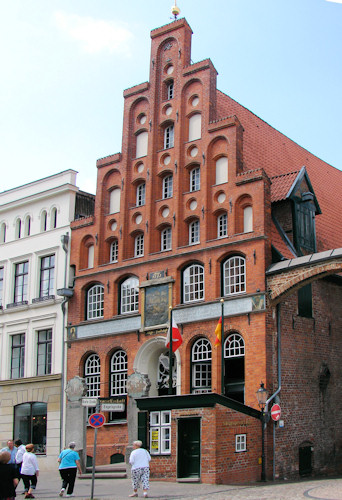
|
| The interior of Schiffers Gesellschaft, with a few of our party visible. | 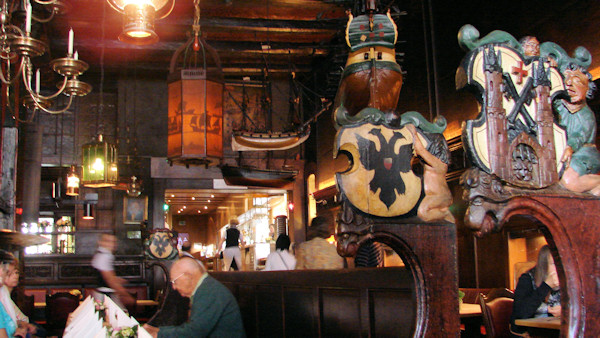
|
| Kiel Canal |
In
the 1880's, Kaiser Wilhelm II decided that the German navy needed a
better way to get from the Baltic to the North Sea. This way was
a 61 mile canal across the German peninsula just south of Denmark, and
it saved 285 miles of steaming. The canal was finished in 1895,
then expanded in 1914 to accommodate the Kaiser's biggest warships.
While
we had a daylight passage, it was very rainy. Still you had the
sense of sailing through German farmland. There were a few
bridges, but every few miles there were ferries to provide crossings. | 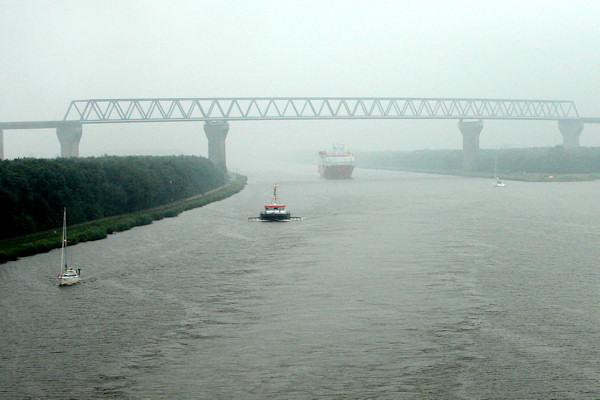 |
| The
bow of MV Discovery, easing toward the Brunsbüttel Locks, which connect
the Kiel Canal to the North Sea. We slept through the Holtenau
Locks that connect the canal to the Baltic Sea. | 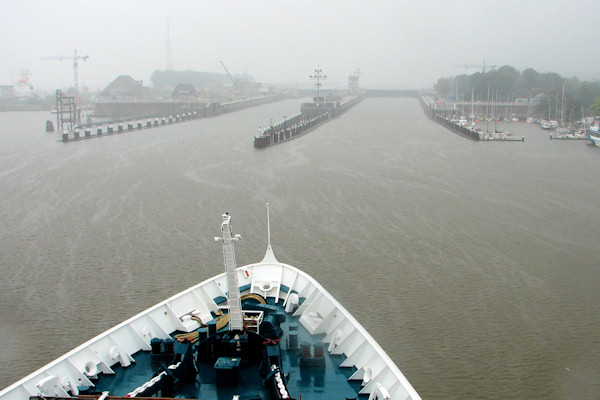 |
| Return to Home Page | Back to Part 1 (London to Tallinn) |
